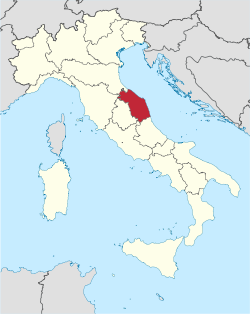
Back Marken ALS ማርኬ Amharic Marcas AN ماركي Arabic Marche AST Marke Azerbaijani مارکه AZB Marché BAN Marche BCL Марке Byelorussian
Marche
the Marches | |
|---|---|
|
| |
| Anthem: Inno delle Marche | |
 | |
| Country | |
| Capital | Ancona |
| Government | |
| • President | Francesco Acquaroli (Brothers of Italy) |
| Area | |
| • Total | 9,366 km2 (3,616 sq mi) |
| Population (2012-10-30) | |
| • Total | 1,541,692 |
| • Density | 160/km2 (430/sq mi) |
| Demonym(s) | Italian: Marchigiano (man) Italian: Marchigiana (woman) |
| GDP | |
| • Total | €42.597 billion (2021) |
| Time zone | UTC+1 (CET) |
| • Summer (DST) | UTC+2 (CEST) |
| ISO 3166 code | IT-57 |
| HDI (2021) | 0.903[2] very high · 8th of 21 |
| NUTS Region | ITI |
| Website | Regione.Marche.it |
Marche (/ˈmɑːrkeɪ/ MAR-kay,[3][4] Italian: [ˈmarke] ), in English sometimes referred to as the Marches (/ˈmɑːrtʃɪz/ MAR-chiz),[5][6][7][8][9][10] is one of the twenty regions of Italy. The region is located in the central area of the country, and has a population of about 1.5 million people, being the thirteenth largest region in the country by number of inhabitants.[11] The region's capital and largest city is Ancona.[12]
The Marche region is bordered by Emilia-Romagna and the republic of San Marino to the north, Tuscany to the west, Umbria to the southwest, Abruzzo and Lazio to the south and the Adriatic Sea to the east. Except for river valleys and the often very narrow coastal strip, the land is hilly. A railway from Bologna to Brindisi, built in the 19th century, runs along the coast of the entire territory. Inland, the mountainous nature of the region, even today, allows relatively little travel north and south, except by twisting roads over the passes.
From the Middle ages to the Renaissance period, many cities of the Marche were important cultural, artistic and commercial centres, the most prominent being Ancona, Pesaro, Urbino, Camerino and Ascoli Piceno.[13]
Urbino, which was a major centre of Renaissance history, was also the birthplace of Raphael, one of the most important painters and architects of that period.[14] The Marche region is also the birthplace of Gentile da Fabriano, Cyriacus of Ancona, Donato Bramante, Giovanni Battista Pergolesi, Giacomo Leopardi, Gioachino Rossini and Maria Montessori.
- ^ "Population on 1 January by age, sex and NUTS 2 region", www.ec.europa.eu
- ^ "Sub-national HDI - Area Database - Global Data Lab". hdi.globaldatalab.org. Retrieved 5 March 2023.
- ^ "Marche 2". The American Heritage Dictionary of the English Language (5th ed.). HarperCollins. Retrieved 6 May 2019.
- ^ "Marche" (US) and "Marche". Lexico UK English Dictionary. Oxford University Press. Archived from the original on 29 February 2020.
- ^ Fodor's (13 March 2012). Fodor's Italy 2012. Random House Digital, Inc. p. 1132. ISBN 978-0-87637-143-5. Retrieved 24 April 2012.
- ^ Touring Club of Italy (1999). The Marches: A Complete Guide to the Region, Its National Parks, and Over a Hundred of Its Towns, Including Urbino. Touring Club of Italy. pp. front cover. ISBN 978-88-365-1467-0.
- ^ The Times, page [1] (...British call it the Marches.).
- ^ Facaros, Dana; Pauls, Michael (1 October 2007). Cadogan Guide Tuscany, Umbria & the Marches. New Holland Publishers. pp. front cover. ISBN 978-1-86011-359-8. Retrieved 24 April 2012.
- ^ "Marche 2". The American Heritage Dictionary of the English Language (5th ed.). HarperCollins. Retrieved 6 May 2019.
- ^ "Marches". Collins English Dictionary. HarperCollins. Retrieved 10 September 2019.
- ^ "Marche". Tuttitalia.it (in Italian). Retrieved 18 January 2023.
- ^ "Le province delle Marche per popolazione". Tuttitalia.it (in Italian). Retrieved 18 January 2023.
- ^ "Storia Marche". www.comuni-italiani.it. Retrieved 18 January 2023.
- ^ "Raphael | Biography, Artworks, Paintings, Accomplishments, Death, & Facts | Britannica". www.britannica.com. Retrieved 18 January 2023.
© MMXXIII Rich X Search. We shall prevail. All rights reserved. Rich X Search

